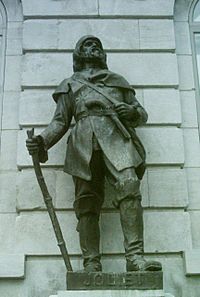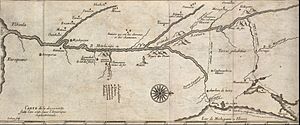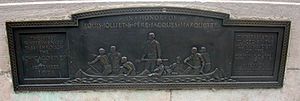Louis Jolliet facts for kids
Quick facts for kids
Louis Jolliet
|
|
|---|---|

Alfred Laliberté's Louis Jolliet sculpture in front of Parliament Building (Quebec)
|
|
| Born | September 21, 1645 near Quebec, New France |
| Died | 1700 (aged 54–55) en route from Quebec to Anticosti Island |
| Allegiance | New France (Canada) |
| Awards | Jolliet was granted land south of Quebec in return for his favours |
| Relations | Jean Jolliet: Father |
| Other work | Canadian explorer |
| Signature |  |
Louis Jolliet (born September 21, 1645 – died sometime after May 1700) was a famous French-Canadian explorer. He made important discoveries in North America. In 1673, Jolliet and Jacques Marquette, a Catholic priest and missionary, were the first non-Native people to explore and map the northern part of the Mississippi River.
Contents
Early Life and Education
Louis Jolliet was born in 1645 in Beaupré, Quebec, a French settlement near Quebec City. His parents were Jean Jolliet and Marie D'Abancourt. When Louis was six, his father died. His mother later married Geoffroy Guillot dit Lavalle, a successful merchant. After Geoffroy died, she married Martin Prevost.
Jolliet's stepfather owned land on the Île d'Orléans, an island in the Saint Lawrence River. This island was home to First Nations people. Louis spent a lot of time there, which likely helped him learn Indigenous languages of the Americas from a young age. Besides French, he also learned English and Spanish.
During his childhood, Quebec was a busy center for the French fur trade. Native people were a big part of daily life in Quebec. Jolliet grew up learning a lot about their cultures. He went to a Jesuit school in Quebec, where he studied philosophy and religion. He even planned to become a priest. He also learned music, becoming a skilled harpsichord and church organ player. In 1662, he received Holy Orders, but he left the seminary in 1667 to become a fur trader instead.
Exploring the Upper Mississippi River
While Hernando de Soto was the first European to officially note the Mississippi River in 1541, Jolliet and Marquette were the first to find its upper parts. They traveled most of its length about 130 years later. De Soto had named the river Rio del Espiritu Santo. However, tribes along the river called it "Mississippi," which means "Great River" in the Algonquian languages.
The Journey Begins
On May 17, 1673, Jolliet and Marquette started their journey from St. Ignace, Michigan. They had two canoes and five other voyageurs, who were French-Indian explorers. The group first sailed to Green Bay. From there, they paddled upstream (south) on the Fox River.
They reached a place now called Portage, Wisconsin. Here, they carried their canoes and gear for less than two miles. They walked through marsh and oak forest to reach the Wisconsin River. Europeans later built a trading post at this spot. It was the shortest way to carry boats between the Great Lakes and Mississippi River areas.
Reaching the Mississippi
On June 17, the explorers finally entered the Mississippi River. This was near what is now Prairie du Chien, Wisconsin. The Jolliet-Marquette expedition paddled along the west bank of the Mississippi until mid-July.
When they passed the mouth of the Arkansas River, they were sure they had found that the Mississippi flowed into the Gulf of Mexico. By this point, they had met Native people carrying European goods. They worried about meeting explorers or colonists from Spain who might be hostile.
The Return Journey
The voyageurs then followed the Mississippi back to the mouth of the Illinois River. Friendly Native people told them this was a shorter way back to the Great Lakes. They followed the Illinois River upstream. Then, they turned up its branch, the Des Plaines River, near modern-day Joliet, Illinois.
They continued up the Des Plaines River and carried their canoes and gear at the Chicago Portage. Next, they followed the Chicago River downstream until they reached Lake Michigan. This was near the location of modern-day Chicago. Father Marquette stayed at the mission of St. Francis Xavier at the southern end of Green Bay, which they reached in August.
Jolliet returned to Quebec to share the news of their discoveries. On his way through the Lachine Rapids, Jolliet's canoe overturned. Sadly, all his records were lost. His short story, written from memory, matches Marquette's main account of the journey.
Later Years and Discoveries
Jolliet married Claire-Françoise Byssot de la Valtrie. She was also born in Canada. Her parents were Francois Byssot de la Riviere and Marie Couillard. Claire Francoise was also the sister of Louise Byssot de la Valtrie.
In 1680, King Louis XIV of France gave Jolliet the Island of Anticosti as a reward. Jolliet built a fort there and kept soldiers. In 1693, he was named "Royal Hydrographer," which meant he was a chief mapmaker for water bodies. On April 30, 1697, he was given land southwest of Quebec City. He named this land Jolliest.
In 1694, he sailed north from the Gulf of St. Lawrence along the coast of Labrador. He went as far north as Zoar. This voyage lasted five and a half months. He wrote down details about the land, how to navigate, and about the Inuit people and their customs. His journal is the earliest known detailed survey of the Labrador coast.
Louis Jolliet left for Anticosti Island in May 1700. After this, he disappears from history. There is no record of his death or burial place. The only record of his fate is a note that a mass for his soul was held in Quebec on September 15, 1700.
Jolliet's Legacy
Jolliet's main legacy can be seen in the Midwestern United States and Quebec. Many places are named after him. These include the cities of Joliet, Illinois; Joliet, Montana; and Joliette, Quebec. Joliette was founded by one of Jolliet's descendants, Barthélemy Joliette.
The name "Jolliet" has several spellings. This is because in the past, many people could not read or write well, and spelling rules were not set. Jolliet's family members still live across eastern Canada and the United States. The Louis Jolliet rose, a type of flower, was named in his honor.
The Jolliet Squadron of cadets at the Royal Military College Saint-Jean in the Province of Quebec was named after him. A street and a subway station in Montreal, Quebec, are also named for him. Joliet Junior College in Joliet, Illinois, is named after the explorer. Many high schools in North America also carry his name.
A cruise ship that sails out of Quebec City is also named in his honor. Jolliet appears with Father Jacques Marquette on a 1968 United States postage stamp. This stamp honors their important exploratory voyage. There is also a mall named after him, the Louis Joliet mall in Joliet, Illinois.
See also
 In Spanish: Louis Jolliet para niños
In Spanish: Louis Jolliet para niños




